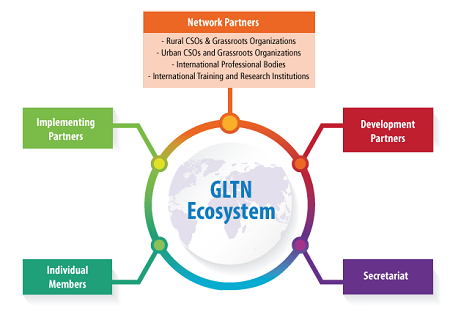GLTN Partners Prepare Phase 4

For continued improvement of land reform and management, emphasizing security of tenure and developing and disseminating pro-poor and gender-sensitive land tools, HIC-HLRN participated at the Global Land Tool Network (GLTN) 9th partners meeting at Nairobi, 2–4 May 2023. That meeting sought to prepare members and partners for the Phase 4 GLTN Program for a period of four years (2024–2027) under the overall framework of the GLTN Strategy 2018–2030. The 9th partners meeting took place in the UN Compound in Gigiri Nairobi, Kenya, under the theme “Securing land tenure for all in a rapidly changing world” with participation of 147 participants from 86 GLTN implementing partners and high-level world leaders.
The preparation for Phase 4 strategy comes after concluding the Phase 3 Strategy (2018–2030) that was focusing on developed more institutionalized approaches and strategic interventions to scale up tools for country-wide implementations and impacts. Phase 4 will cover three priority thematic areas: (1) The inter-relationship between land tenure security and protection of natural resources in multilateral environmental agreements; (2) The inter-relationship between land property rights and inclusive socioeconomic development in multilateral agreements and human rights treaties; (3) Continue Phase 3 priorities on urban development and humanitarian-development nexus. (This construct borrowed from UN-Habitat falls short of the contemporary humanitarian-development-human rights standard.)
Elected members of the four clusters (International Professional Bodies, International Training and Research Institutions, International Rural Civil Society Organizations and International Urban Civil Society Organizations) form a Steering Committee that provides strategic guidance to the GLTN program and work plan, and report back to partners accordingly, and to advise on mechanisms to enhance the dynamism of the Network. Although the Steering Committee members should be considered as institutions, not individuals, the contributions are much more in the members’ personal capacity than their institutional capacity. The meeting emphasized the importance of aligning cluster work plans and addressed the need to improve communication within and among clusters, and with the secretariat. At the end of the session and within the next Phase 4 strategy, the four clusters recommended their upcoming activities and work plans.
The closing session, was focusing on way forward and GLTN Phase 4, at all levels on international and national normative work, and how GLTNs work fit into systems thinking at national, regional and international levels, and not just as spot interventions on different issues. the director of the Global Solutions Division at UN-Habitat, reaffirmed their commitment to support equitable and sustainable access to, use of, and control over land as essential for realizing many human rights, and land tenure security and land management as significant foundational issues for member states and multilateral forums.
During the sessions of the side events that led by partners, HIC-HLRN organized a side event in cooperation with Slum/Shack Dwellers International (SDI) to present experience at community-based data collection, in general, and focus on its application, in particular, to loss and damage associated with climate change. The event presented and discussed options for land tool development in light of the recent decision by the 27th Conference of parties to the climate-change conventions (CoP27) to establish the Loss and Damage Fund.
HIC-HLRN presented a well-developed and practical method of quantifying impacts of land, housing and habitat loss due to human rights violations as a model for determining loss and damage associated with climate change. The presentations build a case for operationalizing recognized climate-justice principles and demonstrate the proven versatility and scalability of a quantification method already applied in 30 applications across seven countries so far.
The discussion included suggestions on how the quantification method could be used in sectoral and national policy and planning, genderized applications and such non-economic values as loss of education and social capital, etc. Other comments focused on the need for debt relief in addition to Loss & Damage Fund grants. Others referred to the hazard of the Loss & Damage Fund benefiting private interests over actual victim needs. For more details about the side event “Sharing tools to remedy loss and damage amid climate change” read the article HIC-HLRN at GLTN 9th Partners meeting.
See HLRN tools and materials on loss and damage associated with climate change:
A presentation and brief concept note on HLRN’s approach to reporting on loss and damage associated with climate change
Join Learning and Advocacy for Climate Justice and Social Production of Habitat
Children’s Rights and the Environment
Green-transition Finance in Egypt
Going Green: Monitoring the Green Transition in the Arab States
In this issue of Land Times/أحوال الأرض:
Reparations & Remedy for Loss & Damage
HLRN Side Event on Loss & Damage
Rights of Children, Future Generations amid the Triple Planetary Crisis
Loss and Damage in Iraq: The Marshes as Example
Green Transformation Finance in Jordan
Image: GLTN organizational chart. Source: GLTN.
|